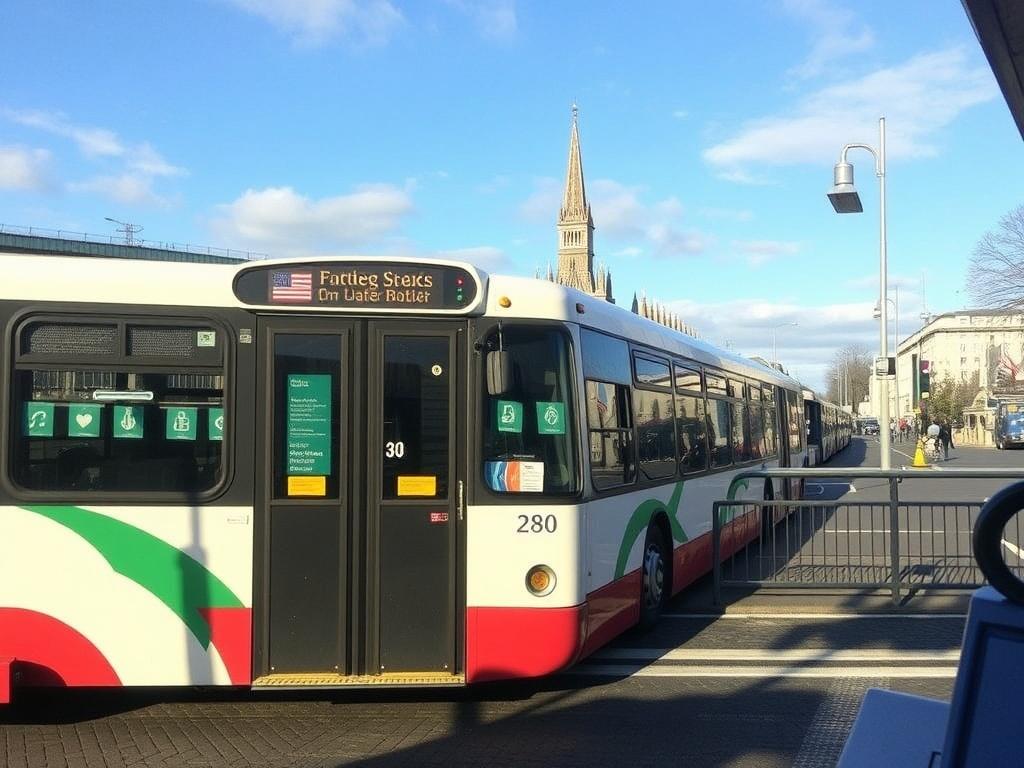
How to Travel with Only Public Transport: A Comprehensive Guide to Exploring Without a Car
Traveling without a car might sound challenging at first, but it can be an incredibly rewarding experience. Whether you’re a city dweller or planning a trip to an unfamiliar place, learning how to travel with only public transport opens up a world of possibilities. You not only save money but also reduce your carbon footprint while immersing yourself in local culture. In this guide, we’ll explore the practical aspects of planning your journey, navigating public transport systems, and making the most out of every trip without ever needing to rent a car or hail a taxi.
Understanding the Basics of Public Transport
When you decide to travel with only public transport, the first step is to familiarize yourself with the types of transportation available. Public transport typically includes buses, trams, subways (metros), commuter trains, and sometimes ferries or cable cars, depending on the city. Each mode has its unique advantages and can serve different purposes during your trip.
Many cities have integrated transport networks that allow you to switch seamlessly between buses and trains, often with one ticket or travel card. This integration makes traveling more convenient and cost-effective. Before setting out, it’s crucial to learn about the schedules, routes, fares, and ticketing systems for your destination.
Types of Public Transport to Consider
| Type of Transport | Description | Best For | Tips for Use |
|---|---|---|---|
| Buses | Road vehicles that travel on set routes throughout cities and rural areas. | Flexibility, reaching suburbs and areas without rail | Check route numbers and timetables; some accept contactless payments. |
| Trams | Electric streetcars running on tracks mostly in urban areas. | City center travel and neighborhoods not covered by subway | Look for tram stops; faster than buses in heavy traffic. |
| Subway (Metro) | Underground trains connecting major urban hubs. | Quick travel within busy cities | Buy day passes or travel cards for cost savings. |
| Commuter Trains | Regional trains connecting city centers with suburbs or nearby towns. | Longer journeys and daily commuting | Check schedules carefully; fewer stops than local trains. |
| Ferries | Water transport for crossing rivers or traveling along coasts. | Scenic routes and areas separated by water | Check seasonal schedules; often cheaper than bridges or tunnels. |
Planning Your Journey Using Public Transport
One of the most crucial skills when you want to travel with only public transport is effective planning. Spending a little time researching routes, checking schedules, and understanding ticketing policies makes your trips smoother and more enjoyable. Luckily, there are many tools and resources to help travelers plan trips on public transportation systems.
Use Transit Apps and Online Maps
Smartphones are invaluable when you travel with only public transport. Most cities have official transit apps or partner with services like Google Maps, Citymapper, or Moovit. These apps allow you to enter your destination and display route options, estimated travel times, and even real-time arrival predictions.
When you use transit apps effectively, you can avoid unnecessary waiting times and find alternate routes if delays occur. They help you understand complex transit networks by breaking your journey into simple transfers.
Understand Ticketing Systems
Ticketing can be confusing because every system is different. Some cities use paper tickets, others have rechargeable smartcards, and many now accept contactless credit/debit cards or mobile payments. Here are some common ticketing options:
- Single-ride tickets: Good if you only plan to take one or two trips during the day.
- Day passes: Unlimited rides for a day, ideal for tourists and those exploring thoroughly.
- Weekly or monthly passes: Useful for longer stays or frequent travelers.
- Reloadable cards: Think of these as transit debit cards.
It’s wise to check if you can buy tickets in advance online or from stations to avoid standing in long lines, especially during peak travel seasons.
Plan for Transfers and Walking
Traveling with only public transport often involves changing vehicles along the route. Be prepared for transfers by noting where they occur and how much walking is involved. Most major transit hubs are designed to be pedestrian-friendly, but sometimes you may need to walk outside or cross streets to catch your next connection.
Carrying a small travel bag with essentials like a water bottle, map, phone charger, and snacks will make waiting and walking more comfortable.
Navigating Public Transport Systems Like a Pro
Once you’re on the move, the key to mastering public transport is confidence and awareness. Don’t worry if you don’t understand every announcement or map detail immediately. With time, you’ll become more comfortable.
Reading Maps and Signs
Public transport systems usually have clear signage, but it can look overwhelming with color-coded lines and multiple stops. Here’s how to decode maps quickly:
- Focus on your starting point and destination first.
- Look for the shortest or simplest route, even if it means changing vehicles.
- Identify important transfer points or hubs.
- Note the direction of travel; some routes loop or branch out.
Many transport systems include English or universally recognized symbols, making things easier for international travelers.
Stay Alert and Safe
Traveling with only public transport requires some street smarts. Keep your belongings close, particularly in crowded areas. Avoid empty or poorly lit stations after dark if possible. Use official or recommended transport routes, and don’t hesitate to ask transit staff or locals for help if you get lost.
If you’re traveling in a group or alone, tell someone your route or use location-sharing apps to stay connected.
Travel Etiquette on Public Transport
Being polite and considerate helps everyone have a better experience. Here are some simple tips:
- Offer seats to elderly, pregnant, or disabled passengers.
- Keep noise levels low; avoid loud conversations or music.
- Queue up and let passengers exit before boarding.
- Keep your space tidy; don’t eat messy food on board.
Good manners make public travel more pleasant and foster better interactions with locals.
Maximizing Your Travel Experience With Public Transport
Why limit yourself to just getting from point A to point B? Traveling with only public transport offers many chances to experience life more deeply wherever you go.
Discover Hidden Gems Off the Beaten Path
Buses and trams often reach neighborhoods and attractions that taxis or private tours do not. Riding local routes can bring you face to face with everyday life—markets, parks, schools, and cafes that show the real rhythm of a place.
Save Money and Extend Your Trip
When you travel with only public transport, your daily transportation cost tends to be much lower than renting a car or calling rideshares. You can stretch your travel budget further and spend more on experiences, food, or souvenirs.
Reduce Your Environmental Impact
Public transport decreases your carbon footprint by reducing the number of vehicles on the road. For travelers who want to be eco-conscious, relying entirely on buses, trains, and ferries is an excellent choice.
Overcoming Common Challenges of Traveling with Only Public Transport
While there are many benefits, traveling with only public transport can sometimes be tricky. Recognizing these challenges will help you prepare better.
Dealing with Unpredictable Delays
Public transport, especially buses, occasionally face delays due to traffic, weather, or maintenance work. Having a backup plan, leaving early, and staying informed with transit apps can help manage this.
Managing Luggage Without a Car
Carrying heavy or bulky luggage can be cumbersome on crowded buses or trains. Opt for lightweight, compact packing and use luggage with wheels. Also, choose accommodation close to major transit lines to minimize walking distance.
Language Barriers and Lack of Information
In some cities, you might find limited English signage or announcements. Download offline maps, carry a phrasebook app, or prepare by learning key transportation phrases in the local language.
Transit System Complexity
Some cities have complex transit networks with many lines and operators. Studying maps in advance and asking locals for the easiest way to your destination can save confusion.
Tips for Specific Traveler Types
Different travelers might have unique concerns when traveling with only public transport. Here are tailored tips:
For Families Traveling with Kids
- Plan routes with minimal transfers to avoid stress.
- Bring snacks and entertainment devices for waiting times.
- Prioritize seating for comfort, especially on long rides.
- Use stroller-friendly transit if available.
For Solo Travelers
- Always let someone know your itinerary.
- Use well-lit and busy stations.
- Use apps to track your rides and get real-time notifications.
For Older Travelers
- Look for transit lines with minimal walking or escalator use.
- Use accessible transport options when possible.
- Carry a travel card to avoid complicated ticket purchases.
Example Itinerary: Exploring a City with Only Public Transport
To illustrate, here’s how you might plan a day trip in a city without using taxis or rental cars.
| Time | Activity | Transport Mode | Notes |
|---|---|---|---|
| 8:00 AM | Breakfast in city center | Walk | Start day close to accommodation |
| 9:00 AM | Visit Museum | Metro to nearest station | Buy day pass for unlimited rides |
| 12:00 PM | Lunch at local market | Bus from museum to market area | Use app to check next bus time |
| 2:00 PM | Explore park & watch ferry crossing | Tram then ferry | Enjoy scenic public transport modes |
| 5:00 PM | Dinner near accommodation | Bus or walk depending on distance | Relax after a full day |
Preparing for Long-Distance Travel With Public Transport
Traveling with only public transport doesn’t mean you’re confined to cities. Many regions have reliable intercity bus and train networks connecting towns and smaller cities. If you plan to explore a larger area or country, consider these tips:
- Book intercity tickets in advance online to secure seats.
- Break long trips into shorter segments to avoid fatigue.
- Use overnight buses or trains to save on accommodation.
- Research regional discount passes.
Final Thoughts and Conclusion
Traveling with only public transport might seem daunting at first, but it is definitely one of the most enriching ways to see the world. It challenges you to be more independent and resourceful, while offering authentic cultural encounters and cost savings. By learning to plan effectively, using modern tools like transit apps, and adopting mindful travel habits, you can confidently explore cities and regions without ever needing a private vehicle. Whether you’re hopping on a bus in a bustling metropolis, riding a ferry across a picturesque river, or catching a train to a neighboring town, public transport connects you to countless memories waiting to be made. So, pack your bag lightly, embrace the adventure, and let the journey on public transport become part of your travel story.




